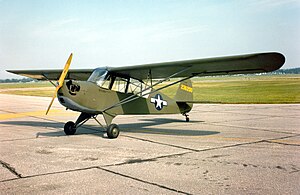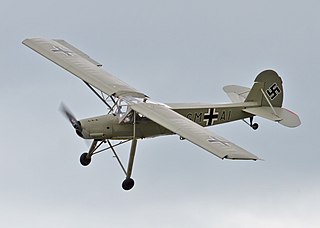
The Fieseler Fi 156 Storch was a German liaison aircraft built by Fieseler before and during World War II. Production continued in other countries into the 1950s for the private market. It was notable for its excellent short field (STOL) performance and low stalling speed of 50 km/h. French-built later variants often appear at air shows.

The Curtiss JN "Jenny" was a series of biplanes built by the Glenn Curtiss Aeroplane Company of Hammondsport, New York, later the Curtiss Aeroplane and Motor Company. Although the Curtiss JN series was originally produced as a training aircraft for the US Army, the "Jenny" continued after World War I as a civilian aircraft, as it became the "backbone of American postwar [civil] aviation".

The Vultee BT-13 Valiant is an American World War II-era basic trainer aircraft built by Vultee Aircraft for the United States Army Air Corps, and later US Army Air Forces. A subsequent variant of the BT-13 in USAAC/USAAF service was known as the BT-15 Valiant, while an identical version for the US Navy was known as the SNV and was used to train naval aviators for the US Navy and its sister services, the US Marine Corps and US Coast Guard.
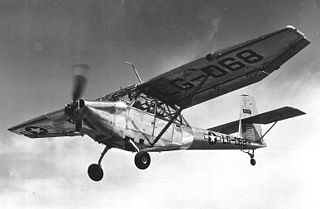
The Stinson L-13 was a US military utility aircraft first flown in 1945.

The Curtiss Robin, introduced in 1928, was a high-wing monoplane built by the Curtiss-Robertson Airplane Manufacturing Company. The J-1 version was flown by Wrongway Corrigan who crossed the Atlantic after being refused permission.

The Bell 47 is a single-rotor single-engine light helicopter manufactured by Bell Helicopter. It was based on the third Bell 30 prototype, which was the company's first helicopter designed by Arthur M. Young. The 47 became the first helicopter certified for civilian use on 8 March 1946. The first civilian delivery was made on 31 December 1946 to Helicopter Air Transport. More than 5,600 Bell 47s were produced, including those under license by Agusta in Italy, Kawasaki Heavy Industries in Japan, and Westland Aircraft in the United Kingdom. The Bell 47J Ranger is a modified version with a fully enclosed cabin and tail boom.
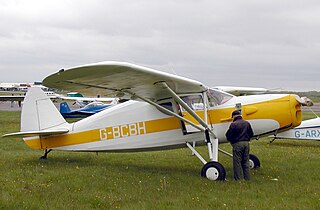
The Fairchild Model 24, also called the Fairchild Model 24 Argus and UC-61 Forwarder, is a four-seat, single-engine monoplane light transport aircraft designed by the Fairchild Aviation Corporation in the 1930s. It was adopted by the United States Army Air Corps as UC-61 and also by the Royal Air Force. The Model 24 was itself a development of previous Fairchild models and became a successful civil and military utility aircraft.

The Lone Star Flight Museum, located in Houston, Texas, is an aerospace museum that displays more than 24 historically significant aircraft, and many artifacts related to the history of flight. Located at Ellington Airport, the museum is housed on about 100,000 ft2 of property, including its own airport ramp. The museum, formerly located in Galveston, moved to Houston to avoid a repeat of the devastation suffered during Hurricane Ike.
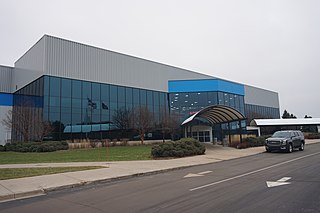
The Air Zoo, founded as the Kalamazoo Aviation History Museum, is an aviation museum and indoor amusement park next to the Kalamazoo-Battle Creek International Airport in Portage, Michigan. The Air Zoo holds many historical and rare aircraft, including the world's fastest air-breathing aircraft, the SR-71B Blackbird. Many of its antique planes are airworthy. Among its other attractions are a 180-degree theater that projects a 2-D film simulation of a B-17 bombing mission during World War II; and various amusement rides, including flight simulators of a rocket trip to Mars, a U.S. Navy F/A-18 Hornet, a stunt biplane, a hot air balloon, a veteran U.S. Navy F-14A Tomcat that served aboard USS America, and more. Air Zoo is a Smithsonian Affiliate.
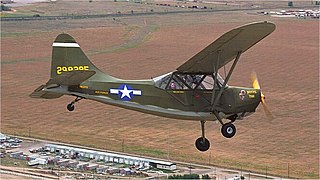
The Stinson L-5 Sentinel is a World War II-era liaison aircraft used by the United States Army Air Forces (USAAF), U.S. Army Ground Forces, U.S. Marine Corps and the British Royal Air Force. It was produced by the Stinson Division of the Vultee Aircraft Company. Along with the Stinson L-1 Vigilant, the L-5 was the only other USAAF liaison aircraft that was exclusively built for military use and had no civilian counterpart.

The Stinson L-1 Vigilant is an American liaison aircraft designed by the Stinson Aircraft Company of Wayne, Michigan and manufactured at the Vultee-Stinson factory in Nashville, Tennessee. The aircraft was operated by the United States Army Air Corps as the O-49 until 1942.
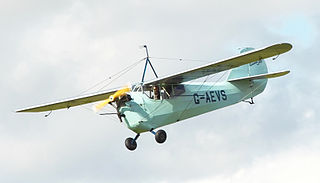
The Aeronca C-3 was a light plane built by the Aeronautical Corporation of America in the United States during the 1930s.
The Dakota Territory Air Museum is an aviation museum on North Hill in Minot, North Dakota near Minot International Airport. The mission of the Dakota Territory Air Museum is to be a historical aviation resource honoring the men, women and machines that have impacted the rich history of aviation through displays and events that educate, inspire and entertain people of all ages. The museum consists of a main information room, outdoor displays, a restoration hangar, the Scott Nelson Gallery, the Texas Flying Legends hangar, Wright Flyer Hangar and the Oswin H. Elker Hangar.
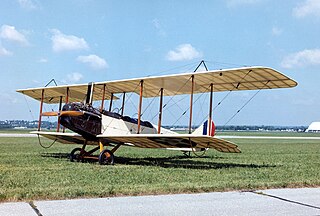
The Standard J is a two-seat basic trainer two-bay biplane produced in the United States from 1916 to 1918, powered by a four-cylinder inline Hall-Scott A-7a engine. It was constructed from wood with wire bracing and fabric covering. The J-1 was built as a stopgap to supplement the Curtiss JN-4 in production.

The Alaska Aviation Museum, previously the Alaska Aviation Heritage Museum, is located on Lake Hood Seaplane Base in Anchorage, Alaska. Its mission since 1988, is to preserve, display, and honor Alaska's aviation heritage, by preserving and displaying historic aircraft, artifacts, and memorabilia, and to foster public interest in aviation and its history. The museum has over thirty aircraft on display, a restoration hangar, flight simulators, two theaters, and a Hall of Fame. It provides an emphasis on historic aircraft, aviation artifacts, and memorabilia that contributed to the development and progress of aviation in Alaska, including Bush flying, and the World War II Army base on Adak Island.

The Vintage Flying Museum is a non-profit aviation museum located at Meacham International Airport, Fort Worth, Texas. The primary mission of the museum is to preserve America's flying heritage in word, deed and action. Also located at the museum is Greatest Generation Aircraft, the Invader Squadron of the Commemorative Air Force, the Fort Worth Chapter of the American Rosie the Riveter Association and PGM Aviation.
The Mid America Flight Museum is an aviation museum located at the Mount Pleasant Regional Airport in Mount Pleasant, Texas.
